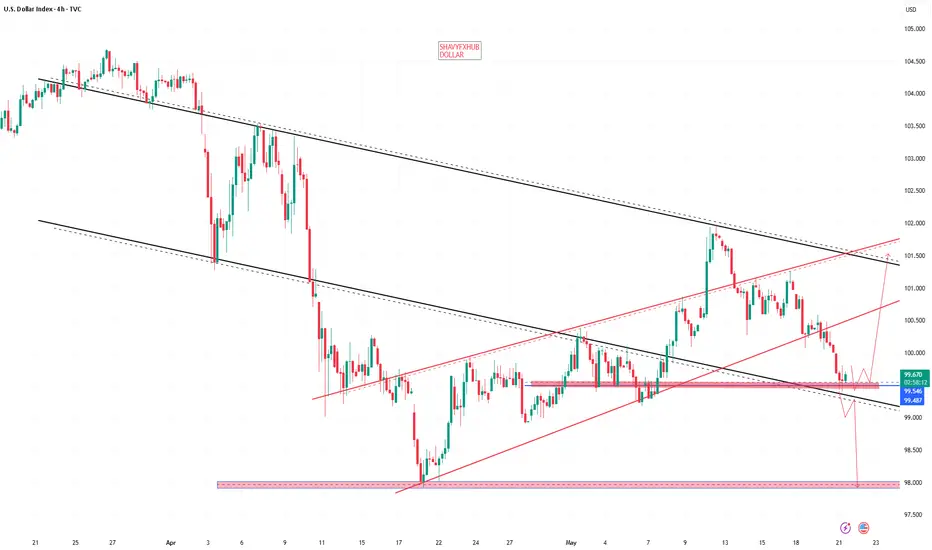DXY (US Dollar Index) and Bond Yield Relationship – May 2025
Current Market Situation
US Treasury Yields:
The 10-year Treasury yield is at 4.54% (May 21, 2025), and the 30-year yield is testing the 5% level amid a global bond sell-off.
DXY (US Dollar Index):
The DXY and the 10-year yield are moving in sync again after a period of divergence earlier in 2025.
Relationship Dynamics
Positive Correlation:
Historically, the DXY and US bond yields (especially the 10-year yield) tend to move together. When yields rise, the dollar often strengthens, as higher yields attract foreign capital seeking better returns.
In recent weeks, this positive correlation has resumed after a brief disconnect in April, when yields surged but the dollar weakened due to shifting investor sentiment and US tariff policy.
Periods of Divergence:
In early April 2025, there was a notable divergence: yields climbed while the dollar fell, reflecting a rare episode where investors were wary of US assets despite higher returns, possibly due to concerns about US fiscal health and global trade tensions.
During that period, both US bonds and the dollar declined together, signaling a potential shift away from US assets and raising questions about the dollar’s structural appeal as a reserve currency.
Recent Realignment:
After the Federal Reserve’s recent meeting and a major tariff agreement with China, the DXY and yields began rising together again, indicating renewed confidence in US assets and a return to more typical market behavior.
Key Factors Influencing the Relationship
Fed Policy:
Expectations for future rate cuts or hikes directly influence both yields and the dollar. Higher expected rates generally support both.
Global Risk Sentiment:
In risk-off scenarios, the dollar can strengthen even if yields fall, due to safe-haven demand.
Trade and Fiscal Policy:
Tariffs and concerns about US debt sustainability can disrupt the usual correlation, as seen in early 2025.
Summary Table
Factor Impact on DXY Impact on Yields Typical Correlation
Rising US Yields Strengthens DXY Yields rise Positive
Fed Rate Hike Expectations Strengthens DXY Yields rise Positive
US Fiscal Concerns Can weaken DXY Yields may rise Can diverge
Global Risk Aversion Strengthens DXY Yields may fall Can diverge
Trade Tensions/Tariffs Mixed Mixed May disrupt correlation
Conclusion
As of May 2025, the DXY and US bond yields have resumed a positive correlation, both rising in response to Fed policy signals and improved risk sentiment following a major tariff agreement. However, earlier in the year, this relationship broke down due to concerns about US fiscal stability and shifting global investment flows. The interplay between DXY and yields remains sensitive to Fed policy, fiscal outlook, and geopolitical developments.
#DOLLAR #DXY
Current Market Situation
US Treasury Yields:
The 10-year Treasury yield is at 4.54% (May 21, 2025), and the 30-year yield is testing the 5% level amid a global bond sell-off.
DXY (US Dollar Index):
The DXY and the 10-year yield are moving in sync again after a period of divergence earlier in 2025.
Relationship Dynamics
Positive Correlation:
Historically, the DXY and US bond yields (especially the 10-year yield) tend to move together. When yields rise, the dollar often strengthens, as higher yields attract foreign capital seeking better returns.
In recent weeks, this positive correlation has resumed after a brief disconnect in April, when yields surged but the dollar weakened due to shifting investor sentiment and US tariff policy.
Periods of Divergence:
In early April 2025, there was a notable divergence: yields climbed while the dollar fell, reflecting a rare episode where investors were wary of US assets despite higher returns, possibly due to concerns about US fiscal health and global trade tensions.
During that period, both US bonds and the dollar declined together, signaling a potential shift away from US assets and raising questions about the dollar’s structural appeal as a reserve currency.
Recent Realignment:
After the Federal Reserve’s recent meeting and a major tariff agreement with China, the DXY and yields began rising together again, indicating renewed confidence in US assets and a return to more typical market behavior.
Key Factors Influencing the Relationship
Fed Policy:
Expectations for future rate cuts or hikes directly influence both yields and the dollar. Higher expected rates generally support both.
Global Risk Sentiment:
In risk-off scenarios, the dollar can strengthen even if yields fall, due to safe-haven demand.
Trade and Fiscal Policy:
Tariffs and concerns about US debt sustainability can disrupt the usual correlation, as seen in early 2025.
Summary Table
Factor Impact on DXY Impact on Yields Typical Correlation
Rising US Yields Strengthens DXY Yields rise Positive
Fed Rate Hike Expectations Strengthens DXY Yields rise Positive
US Fiscal Concerns Can weaken DXY Yields may rise Can diverge
Global Risk Aversion Strengthens DXY Yields may fall Can diverge
Trade Tensions/Tariffs Mixed Mixed May disrupt correlation
Conclusion
As of May 2025, the DXY and US bond yields have resumed a positive correlation, both rising in response to Fed policy signals and improved risk sentiment following a major tariff agreement. However, earlier in the year, this relationship broke down due to concerns about US fiscal stability and shifting global investment flows. The interplay between DXY and yields remains sensitive to Fed policy, fiscal outlook, and geopolitical developments.
#DOLLAR #DXY
Disclaimer
The information and publications are not meant to be, and do not constitute, financial, investment, trading, or other types of advice or recommendations supplied or endorsed by TradingView. Read more in the Terms of Use.
Disclaimer
The information and publications are not meant to be, and do not constitute, financial, investment, trading, or other types of advice or recommendations supplied or endorsed by TradingView. Read more in the Terms of Use.
